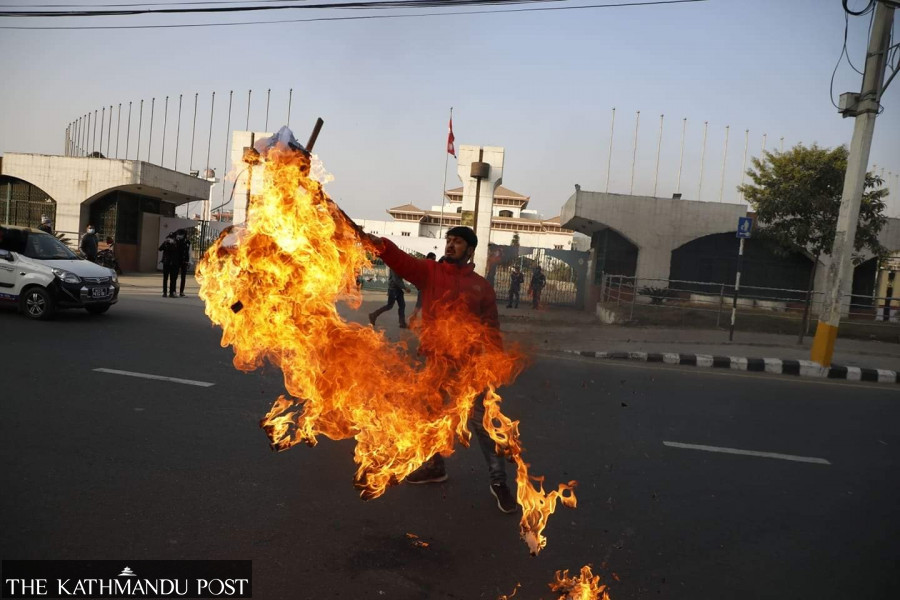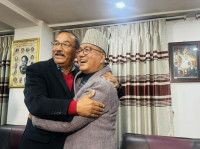Politics
A year of political ups and downs and surprises
Political one-upmanship and power struggles dominated the greater part of 2021.
Anil Giri
The year 2021 had a tumultuous beginning. Prime Minister KP Sharma Oli’s “undemocratic and unconstitutional” move dissolving the House on December 20, 2020 triggered a major political crisis.
Following months of internal discord and conflict within the Nepal Communist Party (NCP), which was born out of a merger between the CPN-UML and the CPN (Maoist Centre) in 2018, Oli suddenly dissolved the lower house of Parliament and declared fresh elections. His move sparked street protests by political parties and civil society groups.
Oli, a prime minister backed by a nearly two-thirds majority, dissolving the House was not simply envisioned in the constitution. But his loyalists defended the move saying that it was always acceptable for the prime minister to seek a fresh mandate in a parliamentary system.
Oli’s House dissolution decision that was swiftly sanctioned by President Bidya Devi Bhandari was challenged in the Supreme Court. In February, the Supreme Court overturned Oli’s decision and reinstated the House of Representatives calling his decision “unconstitutional”.
Following the court’s decision, many had expected Oli to resign on moral grounds, but he did not do so. Instead, the infighting in his party became more intense. Pushpa Kamal Dahal, the other chairman of the NCP, wanted to unseat Oli at any cost.
Amid the festering dispute in the party, the Supreme Court dropped a bombshell on March 7—a division bench of justices invalidated the NCP following a lawsuit challenging the party’s name.
The verdict disqualified the Election Commission’s decision to award the name Nepal Communist Party (NCP) with the abbreviation NCP within brackets to Oli and Dahal, claiming that the name “Nepal Communist Party” had already been registered under the name of Rishiram Kattel in 2013.
And so the country’s largest communist force started disintegrating.
The year 2021 saw the “decline and disintegration” of the leftist forces in Nepal, according to Professor Lok Raj Baral, a former ambassador to India.
“The communist movement that was touted to last at least another 50 years didn’t even survive two years,” Baral said. He said that given the history of Nepal’s communist parties, the party’s break-up seemed somewhat predestined.
“Several communist parties have been formed in the past, only to break up due to petty personal reasons and the egos of their leaders,” said Baral.
The March 7 Supreme Court verdict split the then Nepal Communist Party (NCP) into its pre-merger state–the UML and the Maoist Centre.
Following the break-up, the UML would not be the same again. Senior party leader Madhav Kumar Nepal and his supporters continued to oppose Oli’s “unilateral way” of running the government and the party.
Oli, for his part, continued to snub Nepal for siding with Dahal from the time when the UML and the Maoist Centre were still united.

Nepal and Dahal had formed an alliance within the Nepal Communist Party (NCP) to unseat Oli. After the party split, it was Oli’s turn to get back at them. He refused to acknowledge the Nepal faction.
The dispute inside the UML reached a new height when on May 4 the Maoist Centre pulled its support from the Oli government, turning it into a minority. The Maoist Centre, Nepali Congress and a section of the Janata Samajbadi Party led by Upendra Yadav had already formed an alliance against Oli.
To save his government, Oli had to go for a floor test. On the day of the confidence vote, as many as 28 UML lawmakers from the Nepal faction remained absent. Oli lost the floor test; but on May 13, he was reappointed prime minister as the leader of the party commanding the highest number of parliamentary seats.
After his reappointment, Oli had 30 days to secure a vote of confidence as per the constitutional provision. But instead of going for a floor test, he made an unconstitutional move by requesting the President to invoke Article 76 (5), robbing the House of its prerogative.
The Office of the President approved Oli’s request and called on the political parties to stake claim to form a new government. The opposition alliance led by Nepali Congress President Sher Bahadur Deuba submitted the signatures of 149 lawmakers while Oli submitted the signatures of 121 lawmakers.
But President Bhandari disqualified the petition made by Deuba, saying he lacked adequate support to lay claim to the government.
Oli, who had claimed that he had the backing of 153 lawmakers despite presenting only 121 signatures, once again dissolved the House on May 21. President Bhandari promptly approved his decision.
Again the case was dragged to the Supreme Court. The opposition alliance went to the Supreme Court requesting a mandamus order to appoint Deuba as the new prime minister since he commanded the support of the majority of lawmakers.
On July 12, the Supreme Court overturned the then Prime Minister Oli’s May 21 decision to dissolve Parliament, and ordered the President's Office to appoint Deuba as prime minister.
Thus Oli, who had emerged as the most powerful prime minister in the country’s history, was ousted.
The following month, the Nepal faction of the UML registered a new party, the Communist Party of Nepal (Unified Socialist), which is now part of the coalition government led by Deuba’s Nepali Congress.
Some legal and constitutional experts say that 2021 was the year the country’s leadership failed miserably to deliver on its constitutional duties and strengthen democratic institutions.
“In a blatant assault on democracy and the constitution, the prime minister dissolved the House twice. Ethically, morally and legally, what was envisioned by the constitution and what was expected of democratic institutions could not be achieved. Last year was bad for the constitution and democracy,” said Bhimarjun Acharya, a constitutional expert.
Political one-upmanship and power struggles dominated the greater part of the year. And things didn’t improve much in the later months of the year following Oli’s ouster.
Prime Minister Deuba could not give full shape to his government for months. Furthermore, he followed Oli’s line and made an unconstitutional move of introducing an ordinance to ease the split of political parties.
The Ordinance on Political Party Act helped the UML’s Madhav Nepal faction and the Janata Samajbadi Party’s Upendra Yadav faction to split their respective parties. The two parties along with Dahal’s Maoist Centre are partners in the current coalition government led by Deuba’s Nepali Congress.
The biggest political achievement of the year 2021 was the removal of Oli, according to political analyst Tula Narayan Shah.
“As a result of the split in the Nepal Communist Party, not only Oli, but the UML lost six provincial governments. In Madhesi politics, the unified Rastriya Janata Party Nepal also split. Among the two senior politicians from Madhes, Upendra Yadav gained political ground while Mahantha Thakur became weaker,” said Shah, who has closely followed Madhesi politics for a long time. “On the governance front, Oli and Deuba are on the same page; but one has mishandled several things while Deuba who is more competitively experienced than Oli, is managing several equations in Kathmandu. That’s the difference.”




 9.12°C Kathmandu
9.12°C Kathmandu















